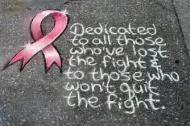
What is breast cancer?
Breast cancer is a disease in which malignant (cancer) cells form in the tissues of the breast. It is considered a heterogeneous disease—differing by individual, age group, and even the kinds of cells within the tumors themselves. Obviously no woman wants to receive this diagnosis, but hearing the words “breast cancer” doesn’t always mean an end. It can be the beginning of learning how to fight, getting the facts, and finding hope.
Women in the United States get breast cancer more than any other type of cancer except for skin cancer. It is second only to lung cancer as a cause of cancer death in women.
Each year it is estimated that nearly 200,000 women will be diagnosed with breast cancer and more than 40,000 will die. Approximately 1,700 men will also be diagnosed with breast cancer and 450 will die each year. The evaluation of men with breast masses is similar to that in women, including mammography.
Signs & Symptoms
Common signs & symptoms of breast cancer include:
-
A change in how the breast or nipple feels
You may experience nipple tenderness or notice a lump or thickening in or near the breast or in the underarm area. -
A change in how the breast or nipple looks
This could mean a change in the size or shape of the breast or a nipple that is turned slightly inward. In addition, the skin of the breast, areola or nipple may appear scaly, red or swollen or may have ridges or pitting that resembles the skin of an orange. -
Nipple discharge
Early Detection Plan
An Early Breast Cancer Detection Plan should include:
-
Beginning at age 20: Performing breast self-exams and looking for any signs of change.
-
Age 20 to 39: Scheduling clinical breast exams every three years.
-
By the age of 40: Having a baseline mammogram and annual clinical breast exams.
-
Ages 40 to 49: Having a mammogram every one to two years depending on previous findings.
-
Ages 50 and older: Having a mammogram every year.
-
All Ages:
— Recording personal exams, mammograms and doctors'
appointments on a calendar or in a detailed file.
— Maintaining a healthy weight, following a low-fat diet, getting regular exercise, quitting smoking, and reducing alcohol consumption.
Self-Exam
Taking a few minutes to do a breast self-exam a minimum of once a month can make a lifetime of difference. Nearly 70% of all breast cancers are found through self-exams and with early detection the 5-year survival rate is 98%.